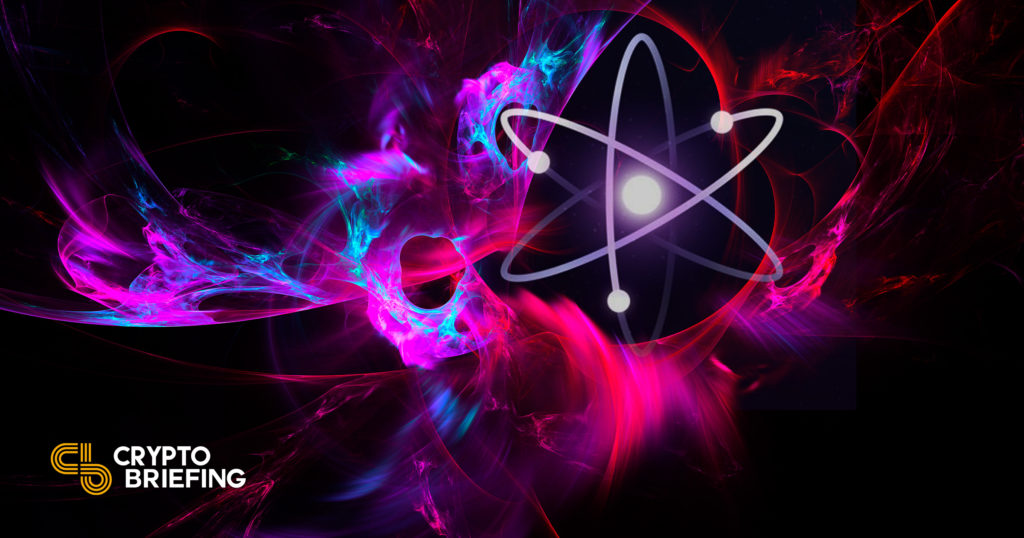Key Takeaways
- After a hotly contested vote, the Cosmos Hub community rejected the proposal to implement the ATOM 2.0 whitepaper.
- 37.99% of tokens voted for ‘NoWithVeto’, indicating strong community resistance.
- The proposal sparked controversy over its updated tokenomics and the desire to implement multiple complex new tools at once.
Share this article
The ATOM 2.0 proposal was rejected by the Cosmos Hub community in a hotly contested vote; the proposal failed despite the support of the majority of voters.
ATOM 2.0 fails
After weeks of debate and a tense two-week voting period, the Cosmos Hub community decided earlier this morning to reject proposal #82, “ATOM 2.0: A New Vision for Cosmos Hub.”
Based on a white paper The proposal, written by Cosmos co-founder Ethan Buchman and eleven others, was marketed as the next step in the evolution of Cosmos Hub. The whitepaper suggested, among other things, drastically changing ATOM’s tokenomics and building two new tools, the Interchain Allocator and the Interchain Scheduler, which they claimed would help cement Cosmos Hub as one of the most important appchains in the broader Cosmos ecosystem.
The proposal, now considered by some in the community to be the most controversial in Cosmos history, saw an unusually high turnout of 73.41% of all ATOM tokens, with votes remaining tight until the end. Ultimately, 47.51% of the coins voted in favor, 37.39% voted “NoWithVeto”, 13.27% abstained and 1.82% simply voted no.
While most of the tokens were indeed pledged in favor, Cosmos Hub’s governance mechanisms ensure that a proposal cannot be passed if more than 33.4% of voters opt for “NoWithVeto” – a system that prevents the Hub from falling prey to attacks of 51%. “NoWithVeto” is therefore a strong signal that community members use to convey their belief that a proposal is actively harmful to Cosmos Hub’s interests.
Buchman recognized the strong response against the proposal in a tweetstorm: “To those who voted NoWithVeto, I respect your decision and hear you loud and clear: the proposal in its current form is untenable. Even if it were passed, changes would be needed!”
Why was it rejected?
ATOM 2.0 was an ambitious and exciting proposal, and that may have been part of the problem.
The 26-page whitepaper was not limited to changing one or two aspects of the ATOM token, as the community initially expected, but aimed to fundamentally transform the way the Cosmos Hub functioned by introducing three new key tools in addition to refreshing of tokenomics. . For example, the Interchain Scheduler aims to be an on-chain MEV marketplace, while the Interchain Allocator’s role would be to enable mutual interest in different IBC chains; these are two very different, very complex topics, and ATOM stakeholders may have ultimately voted against the proposal because of one of the instruments, despite liking the other.
Another lively issue in the ATOM 2.0 proposal had to do with the updated tokenomics. The whitepaper advocated sharply increasing the issuance of ATOM tokens for a short time to subsidize the Hub, and then reducing emissions over a 36-month period. Critics argued that the change in monetary policy was not justified and that details were missing on how the Hub would use the collected ATOM. Others were not convinced that ATOM emissions could be successfully replaced by other sources of revenue by the time emissions declined.
Most likely, the various components of the ATOM 2.0 whitepaper will eventually be put back to the community for a vote as their own individual projects, much like a detailed proposal for Interchain Security – another ambitious initiative to position Cosmos Hub as a central part of the Cosmos ecosystem was adopted in March.
Disclaimer: At the time of writing, the author of this piece owned ATOM, BTC, ETH, and several other cryptocurrencies.
Share this article


